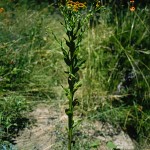Smallhead Sneezeweed
Helenium microcephalum
Asteraceae (Sunflower Family)
Description
Smallhead sneezeweed is an erect, branching, annual (sometimes biennial) herb with alternate, oblong leaves that end in a point. The leaves extend down the stem to form a winged stem. The plant is a composite (sunflower family), with many small yellow flowers growing from May to October. The disk flowers (central cone) appear somewhat spherical and are equal to or more obvious than the yellow ray flowers (flower petals).
Habitat
Smallhead sneezeweed is usually found in moist habitats around tanks and ponds and in bar ditches. A wet fall and spring usually assures a good crop of seedlings. Common in the western half of Texas, it also may be found throughout the state except in the East Texas Piney Woods. It grows southward into Mexico.
Toxic Agent
The toxic agent is a sesquiterpene lactone commonly referred to as dugaldin (helenalin). Sheep are most often poisoned, although goats and cattle also may be susceptible. Horses and mules are also very sensitive to the toxin. Smallhead sneezeweed is extremely toxic in the flowering stage. In feeding studies, as little as 0.25 percent of an animal's body weight produced acute poisoning and death. Mature plants are more toxic than seedlings, and the winter basal rosette stage seems to lack toxicity.
Signs of Livestock Ingestion
Sneezeweed poisoning is nicknamed "spewing sickness." Signs of illness appear within a few hours of consumption and include: Weakness and staggering; Diarrhea; Vomiting green material; Green salivation and nasal discharge; Bloating; Groaning and grinding of teeth; Sticky nonpelleted feces; Gastroenteritis.
Respiration is usually forced and fast, and the pulse, irregular and rapid. Animals may convulse immediately before death. Postmortem examination may reveal an inflamed gastrointestinal tract with edema in the walls of the stomach, lungs and membranes surrounding the lungs and lining of the abdominal cavity. Also, hemorrhages may be evident within the heart chambers.
Management Strategies
In early poisoning stages, administer large doses of mineral oil or intestinal purgatives to help prevent losses. Fencing livestock away from localized infested areas during plant maturation can eliminate potential problems.
Because it is usually in localized areas, hand-pulling, mowing or burning may be effective also. The plant is highly susceptible to most broadleaf herbicides.
Before plants mature, small populations may be treated with ground broadcast applications. Scout potential habitat areas in the fall when the number of plants in the basal rosette stage can indicate the potential severity of a problem. Control the plant in fields used for green chop or hay.
Images
Plant Characteristics
Flower Color: Yellow
Seed Type: Non-Encapsulated
Duration: Annual, Biennual
Stem Texture: Hairless/Smooth
Growth Habit: Forbs/Broadleaf
Leaf Shape
 : Simple with Pinnate or Parallel Venation
: Simple with Pinnate or Parallel Venation
Season: Warm
Distribution
 : 02 - Gulf Prairies and Marshes, 03 - Post Oak Savannah, 04 - Blackland Prairies, 05 - Cross Timbers and Prairies, 06 - South Texas Plains, 07 - Edwards Plateau, 08 - Rolling Plains, 09 - High Plains, 10 - Trans-Pecos
: 02 - Gulf Prairies and Marshes, 03 - Post Oak Savannah, 04 - Blackland Prairies, 05 - Cross Timbers and Prairies, 06 - South Texas Plains, 07 - Edwards Plateau, 08 - Rolling Plains, 09 - High Plains, 10 - Trans-Pecos
Distributions
Distribution refers to the ecological region in Texas that a plant has been found. You can also view a clickable map.
Book: Toxic Plants of Texas (B-6105)
Collection: Toxics, Wild Flowers
Livestock Affected: Cattle, Goats, Horses, Sheep
Livestock Signs: Abdominal Pain, Colic, Depression/ Weakness, Diarrhea, Excess Salivation, Incoordination, Vomiting/Regurgitation





